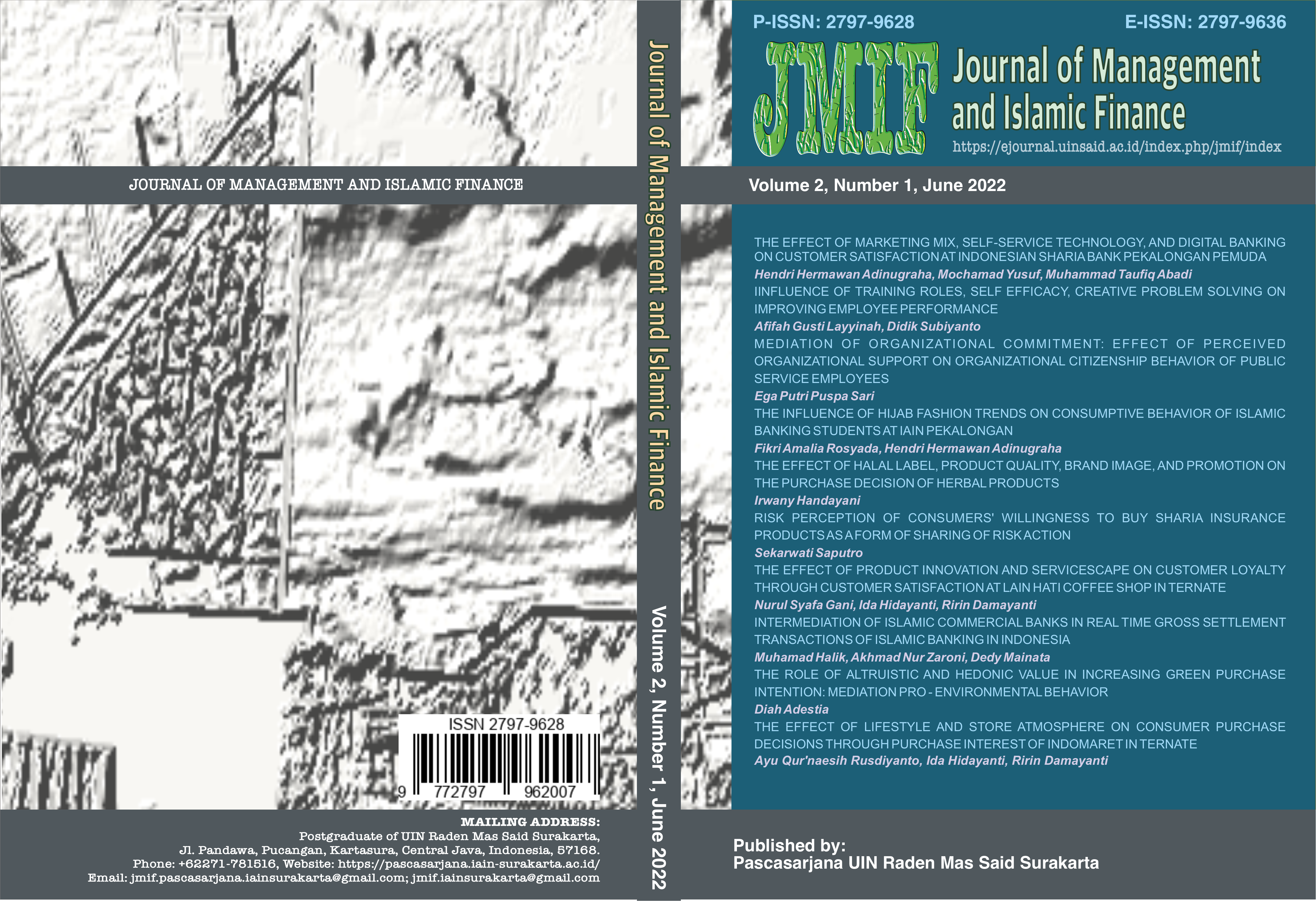RISK PERCEPTION OF CONSUMERS' WILLINGNESS TO BUY SHARIA INSURANCE PRODUCTS AS A FORM OF SHARING OF RISK ACTION
DOI:
https://doi.org/10.22515/jmif.v2i1.5234Keywords:
Perceptions of risk, Probability of disaster, Individual fear, Experience, Sharia insuranceAbstract
This study aims to analyze the influence of risk perception on consumers' willingness to buy Sharia insurance in Wonogiri Regency. This research is included in quantitative research. The population of this study is a resident of Wonogiri district who is Muslim. The sample collected in this study was as many as 100 respondents. Sample selection technique is to use purposive sampling where the sample is determined based on certain criteria. SmartPLS 3.0 is used in research as an analytical tool. The results of this study show that (1) The chance of disaster has no effect on the willingness to buy Sharia insurance. (2) The chance of disaster has a significant positive effect on the fear of the individual. (3) Individual fear has a significant positive effect on the willingness to buy Sharia insurance. (4) Individual fears mediate between the chance of disaster and the willingness to buy Sharia insurance. (5) Experience has a significant positive effect on the willingness to buy Sharia insurance. (6) Experience has no effect on individual fears. (7) The fear of individuals is not able to mediate between experience and willingness to buy Sharia insurance.
Downloads
References
Cenora, E., & Hermawan, D. (2022). Asuransi dan Pandemi Covid-19: Peran Persepsi Konsumen dalam Keputusan Pembelian. Ekonomi, Keuangan, Investasi Dan Syariah (EKUITAS), 3(3), 386–394. https://doi.org/10.47065/ekuitas.v3i3.1033
Ghozali, I., & Hengky Latan. (2014). Partial Least Squares Konsep, Tehnik dan Aplikasi Menggunakan Program SmartPLS 3.0 Untuk Penelitian Empiris. Badan Penerbit UNDIP.
Kinateder, M. T., Kuligowski, E. D., Reneke, P. A., & Peacock, R. D. (2015). Risk perception in fire evacuation behavior revisited: definitions, related concepts, and empirical evidence. Fire Science Reviews, 4(1). https://doi.org/10.1186/s40038-014-0005-z
Mukhsinun, & Fursotun, U. (2018). Dasar Hukum Dan Prinsip Asuransi Syariah Di Indonesia. LABATILA: Jurnal Ilmu Ekonomi Islam, 2(01), 53–73. https://doi.org/10.33507/lab.v2i01.107
Parsaulian, B. (2018). Prinsip Dan Sistem Operasional Asuransi Syariah (Ta’Min, Takaful Atau Tadhamun) Di Indonesia. EKONOMIKA SYARIAH : Journal of Economic Studies, 2(2), 172–190. https://doi.org/10.30983/es.v2i2.727
Poan, R., Merizka, V. E., & Komalasari, F. (2021). The importance of trust factor in the intentions to purchase Islamic insurance (takaful) in Indonesia. Journal of Islamic Marketing. https://doi.org/10.1108/JIMA-01-2021-0026
Ramadhani, H. (2015). Prospek Dan Tantangan Perkembangan Asuransi Syariah Di Indonesia. AL-TIJARY, 1(1), 57–66.
Raza, S. A., Ahmed, R., Ali, M., & Qureshi, M. A. (2020). Influential factors of Islamic insurance adoption: an extension of theory of planned behavior. Journal of Islamic Marketing, 11(6), 1497–1515. https://doi.org/10.1108/JIMA-03-2019-0047
Slovic, P., & Peters, E. (2006). Risk Perception and Affect. Current Directions in Psychological Science, 16(5), 322–325. https://doi.org/10.1111/j.1467-8721.2006.00461.x
Sugiyono. (2017). Metode Penelitian Kuantitatif, Kualitatif, danR&D. PT Alfabet.
Surti, C., Celani, A., & Gajpal, Y. (2020). The newsvendor problem: The role of prospect theory and feedback. European Journal of Operational Research, 287(1), 251–261. https://doi.org/10.1016/j.ejor.2020.05.013
Syakir, M. (2004). Asuransi Syariah (Life and General): Konsep dan Sistem Operasional. Jakarta: Gema Insani.
Taroreh, O., Jorie, R. J., & Wenas, R. (2015). Pengaruh Persepsi Konsumen Dan Kepercayaan Terhadap Penggunaan Jasa Asuransi Pada Asuransi Jasindo Manado. Jurnal Riset Ekonomi, Manajemen, Bisnis Dan Akuntansi, 3(3), 312–321.
Tho’in, M., & Anik. (2015). Aspek-Aspek Syariah dalam Asuransi Syariah. Jurnal Ilmiah Ekonomi Syariah, 1(01), 4.
Xu, D., Peng, L., Liu, S., & Wang, X. (2018). Influences of Risk Perception and Sense of Place on Landslide Disaster Preparedness in Southwestern China. International Journal of Disaster Risk Science, 9(2), 167–180. https://doi.org/10.1007/s13753-018-0170-0
Yang, F., Tan, J., & Peng, L. (2020). The effect of risk perception on the willingness to purchase hazard insurance—A case study in the Three Gorges Reservoir region, China. International Journal of Disaster Risk Reduction, 45. https://doi.org/10.1016/j.ijdrr.2019.101379
Zaleskiewicz, T., Piskorz, Z., & Borkowska, A. (2002). Fear or money? Decisions on insuring oneself against flood. Risk, Decision & Policy, 7(3), 221–233.
Zhang, C. M., & Qian, Z. W. (2018). Minority community willingness to pay for earthquake insurance. Disaster Prevention and Management: An International Journal, 27(5), 556–572. https://doi.org/10.1108/DPM-04-2018-0129
Downloads
Published
Issue
Section
Citation Check
License
Copyright (c) 2022 Sekarwati Saputro

This work is licensed under a Creative Commons Attribution-ShareAlike 4.0 International License.
Authors who publish with this journal agree to the following terms:
- Authors retain copyright and grant the journal right of first publication with the work simultaneously licensed under a Creative Commons Attribution License that allows others to share the work with an acknowledgement of the work's authorship and initial publication in this journal.
- Authors are able to enter into separate, additional contractual arrangements for the non-exclusive distribution of the journal's published version of the work (e.g., post it to an institutional repository or publish it in a book), with an acknowledgement of its initial publication in this journal.
- Authors are permitted and encouraged to post their work online (e.g., in institutional repositories or on their website) prior to and during the submission process, as it can lead to productive exchanges, as well as earlier and greater citation of published work.






